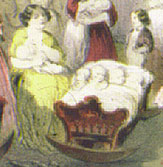The Baby Show ExhibitThe Lost Museum Archive

The “National Baby Show” was one of the American Museum’s most popular competitions. The first baby show in June 1855 attracted more than 60,000 patrons eager to view the 143 contestants who were to be judged “especially on the crowning merit of their being genuine original American stock” (omitting from the competition infants deemed too poor or “foreign” in appearance). Following up on his success in New York, Barnum quickly staged baby shows in several other cities. Despite Barnum’s attempts to portray the shows as grounded in scientific inquiry (contestants answered questions about hygiene, diet, and exercise), many middle-class observers questioned the propriety of displaying mothers and children for commercial gain.
The Baby Show poster hanging on the wall of the “Picture Gallery” in The Lost Museum is a composite of images and text from primary sources.